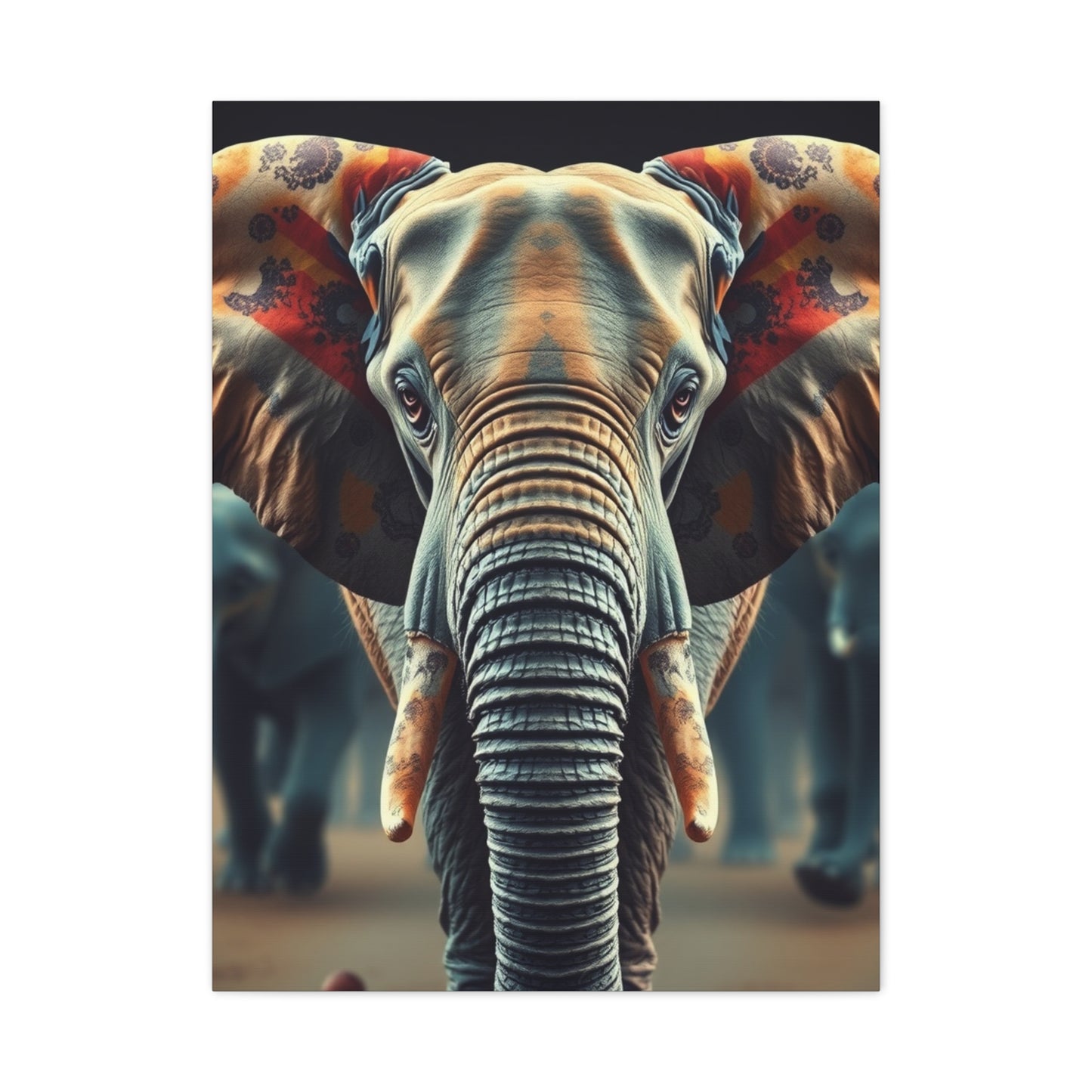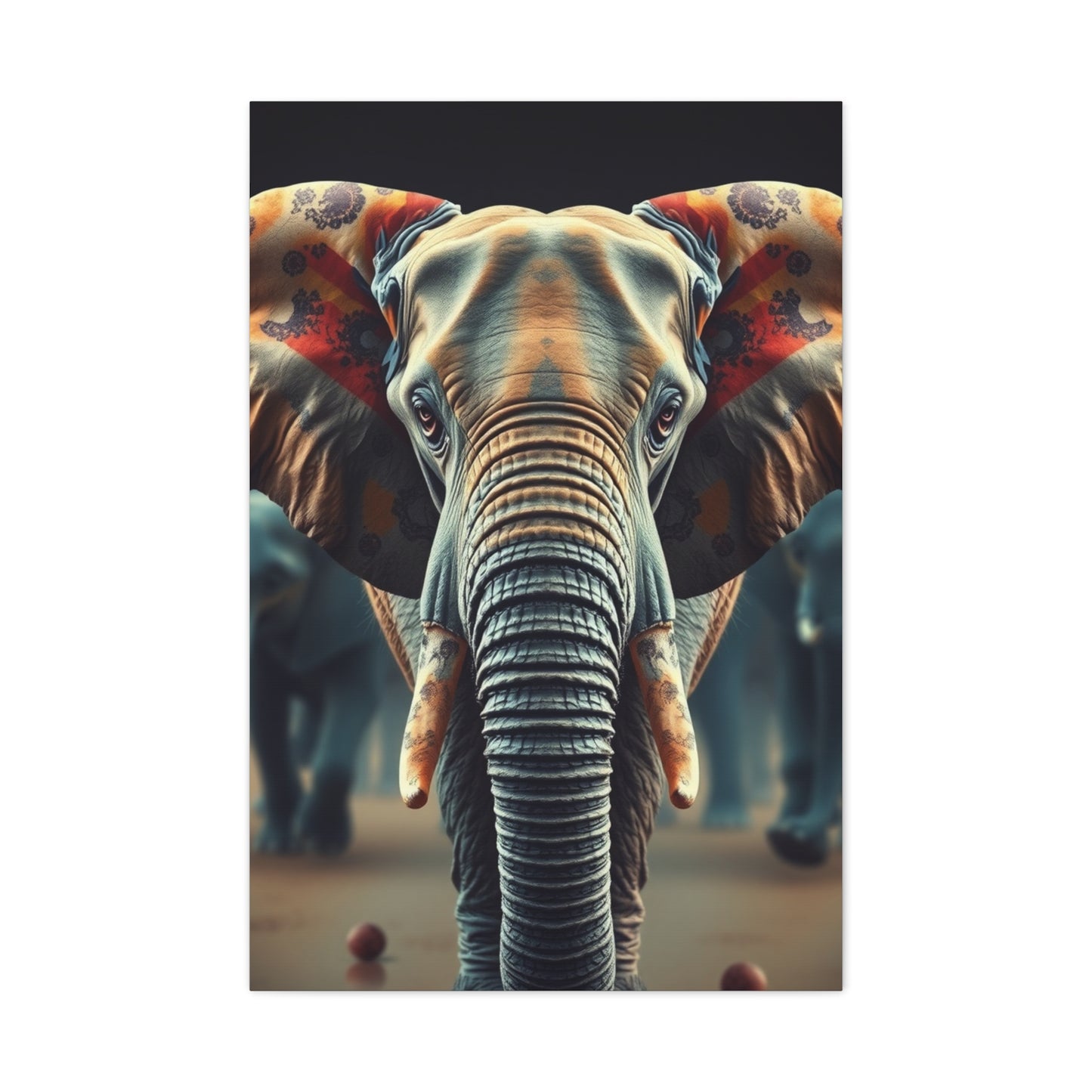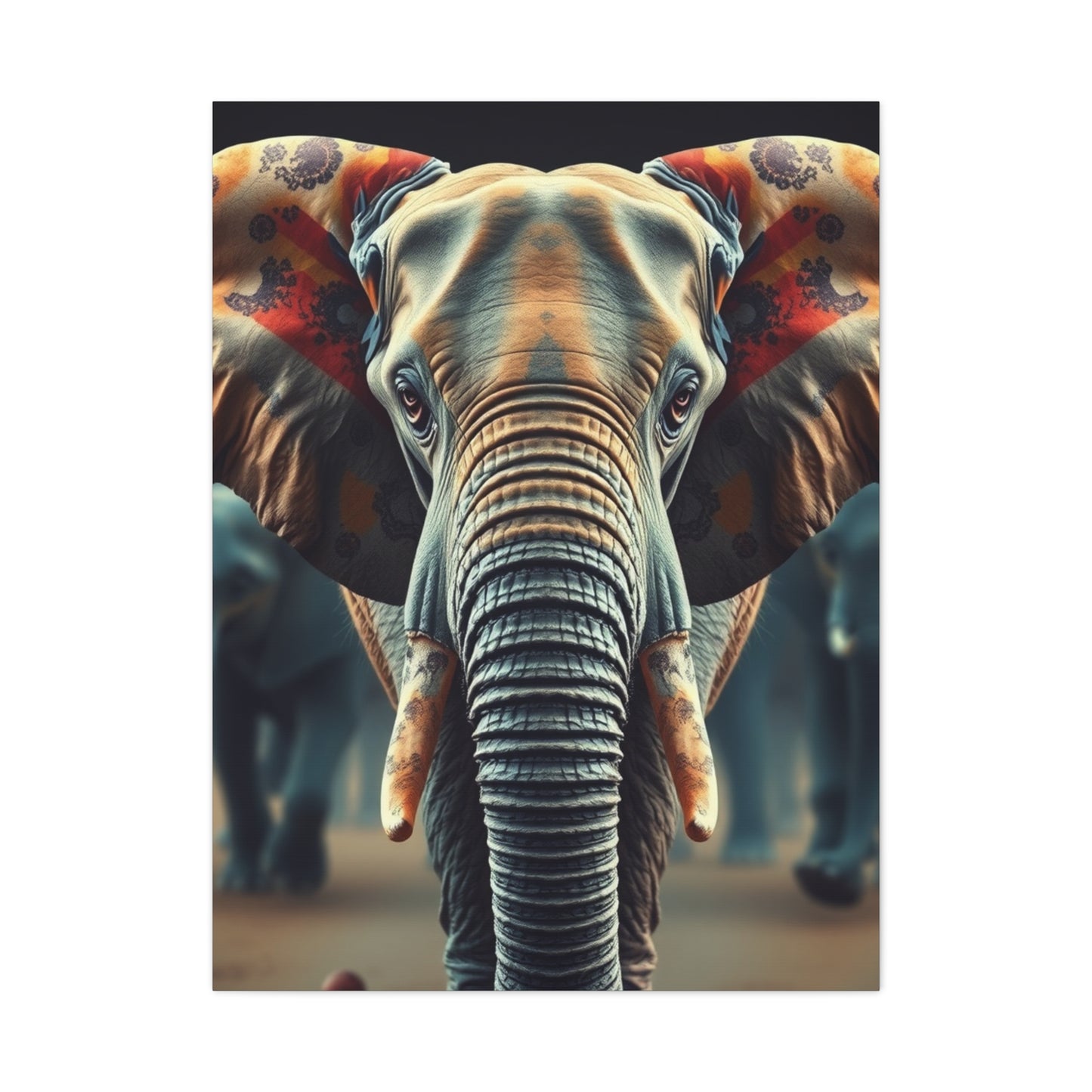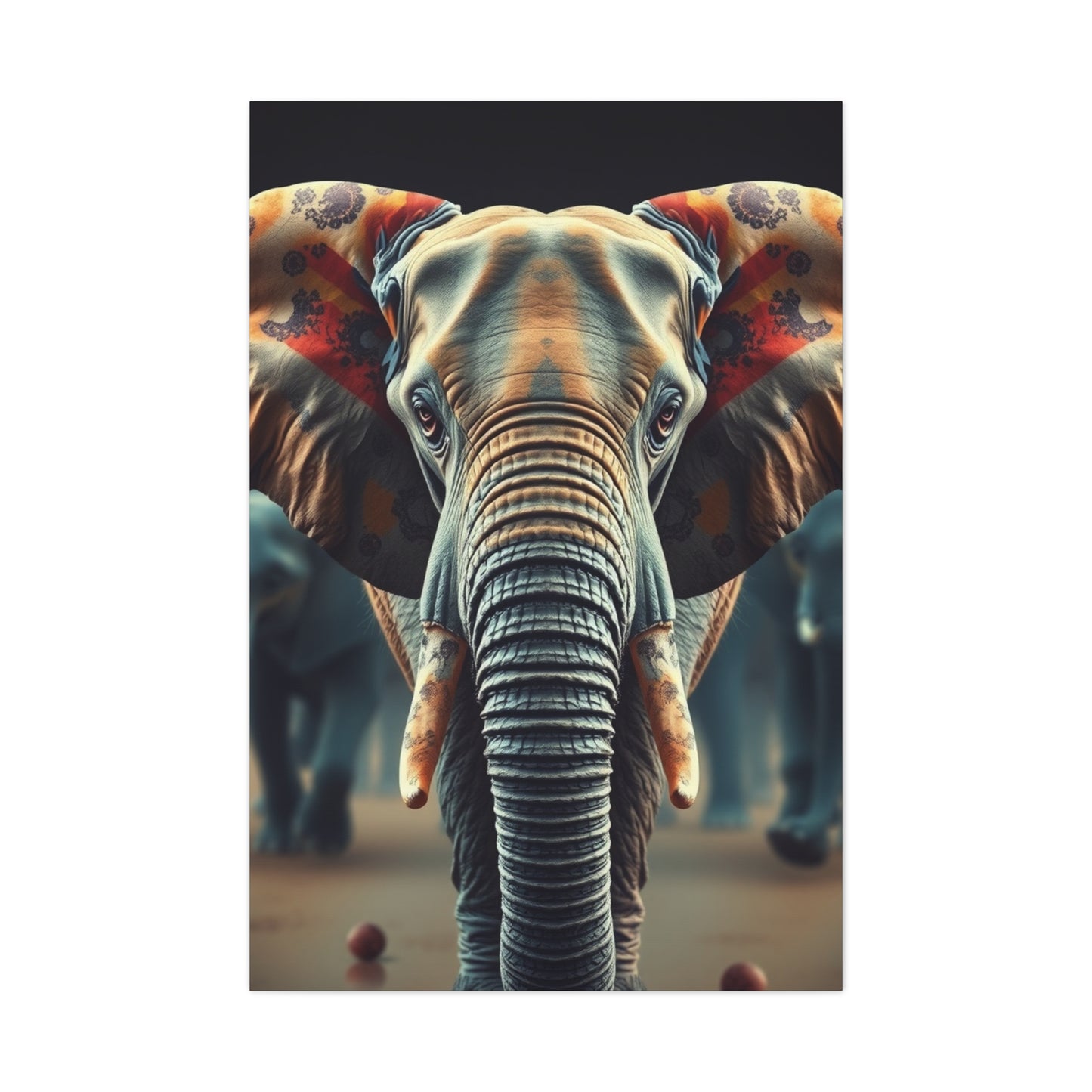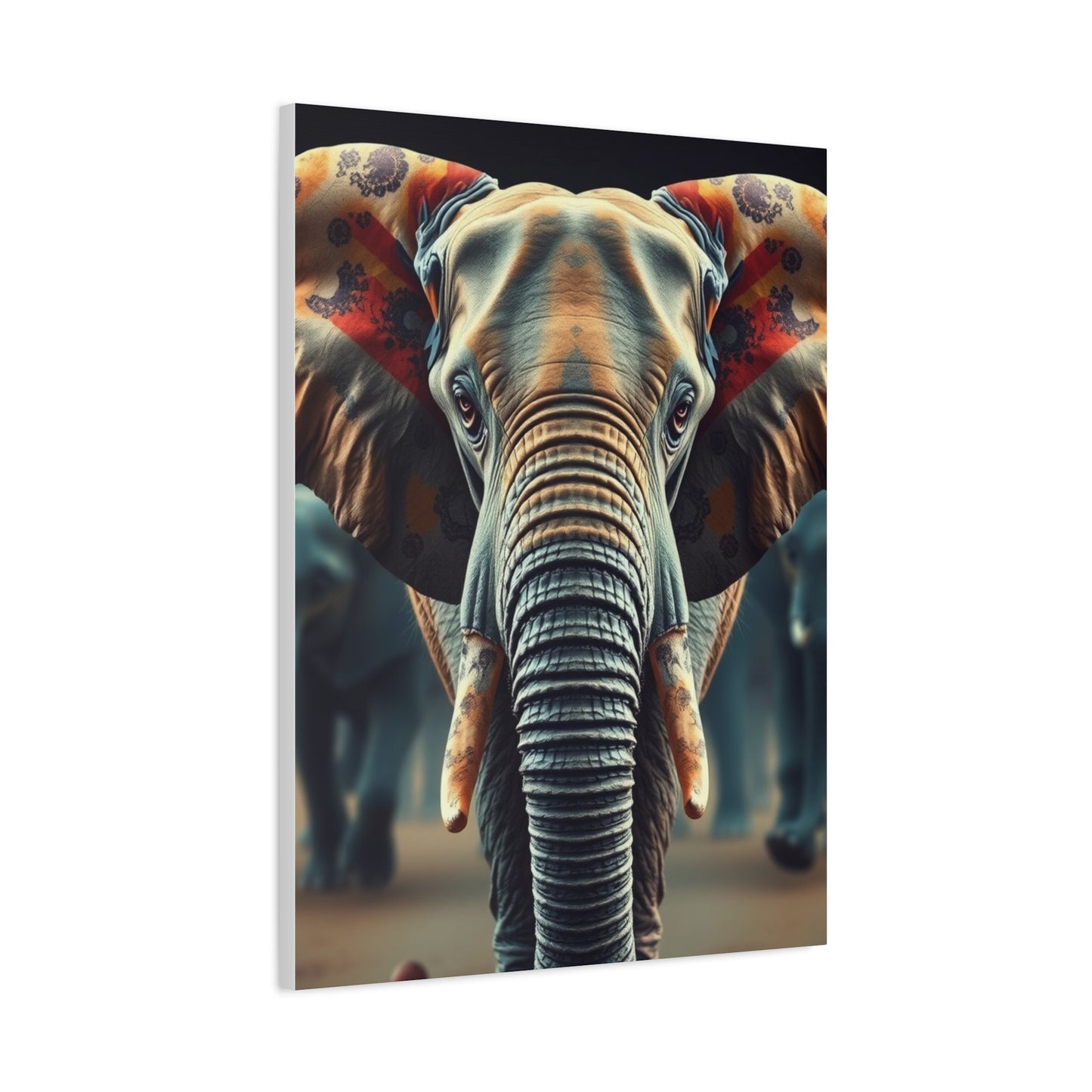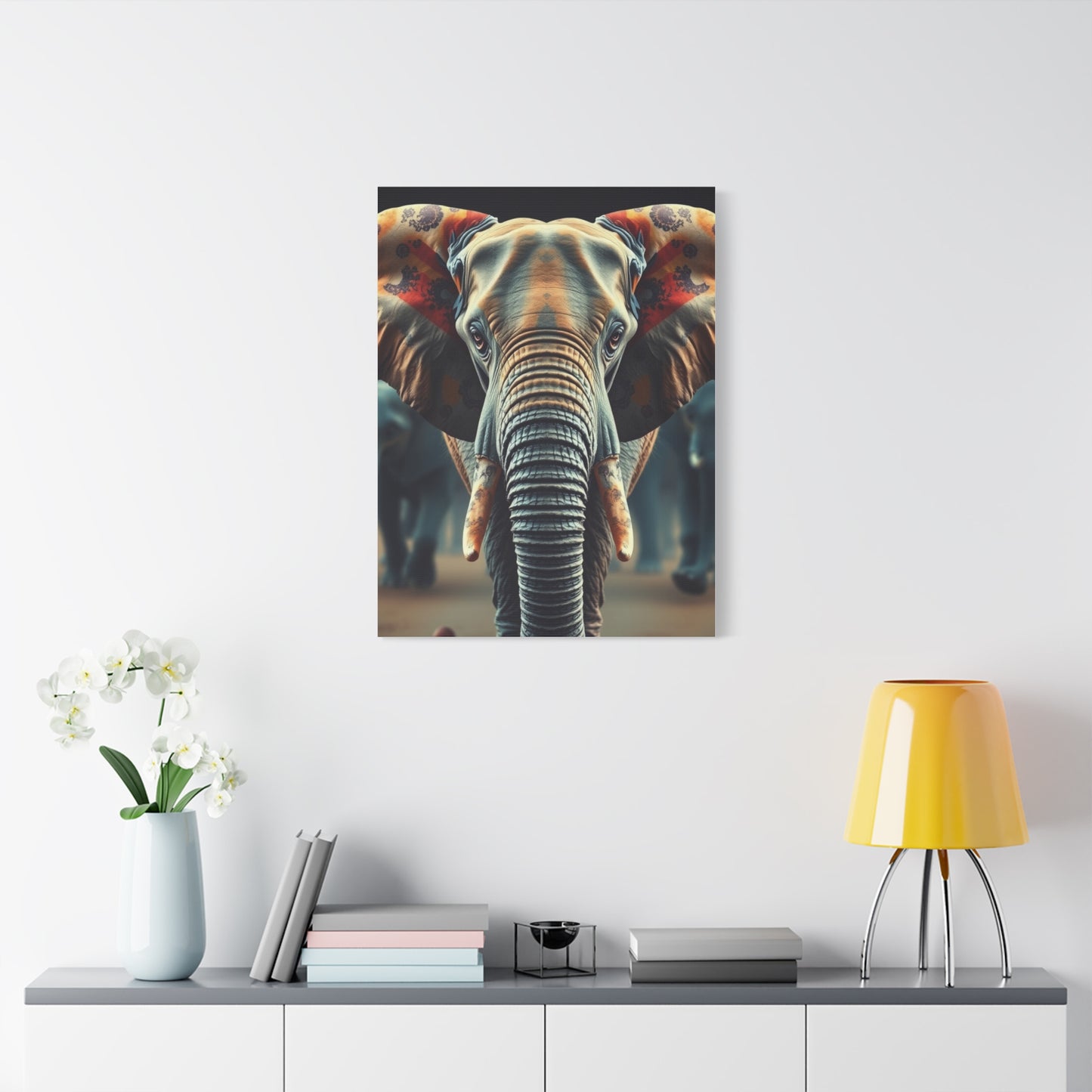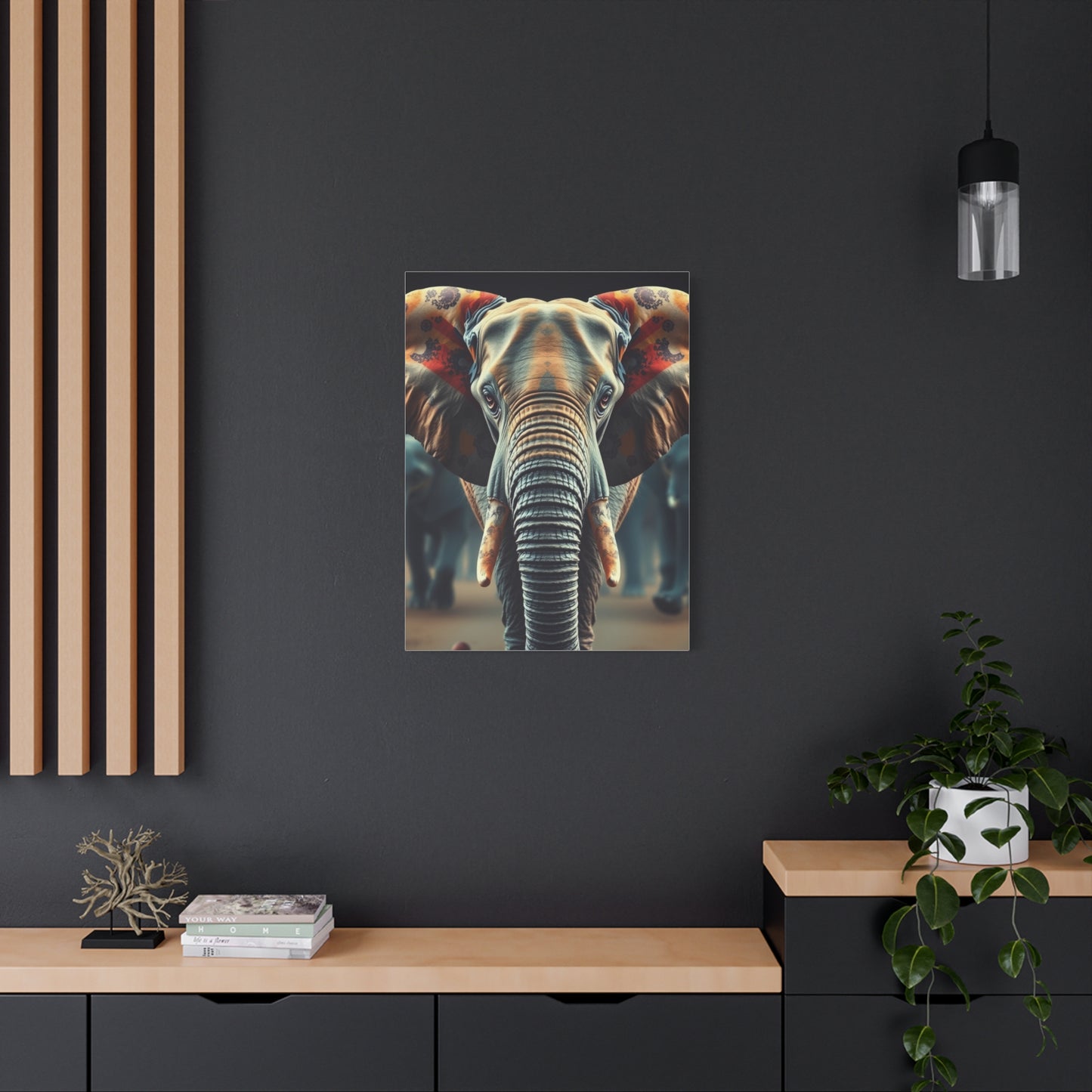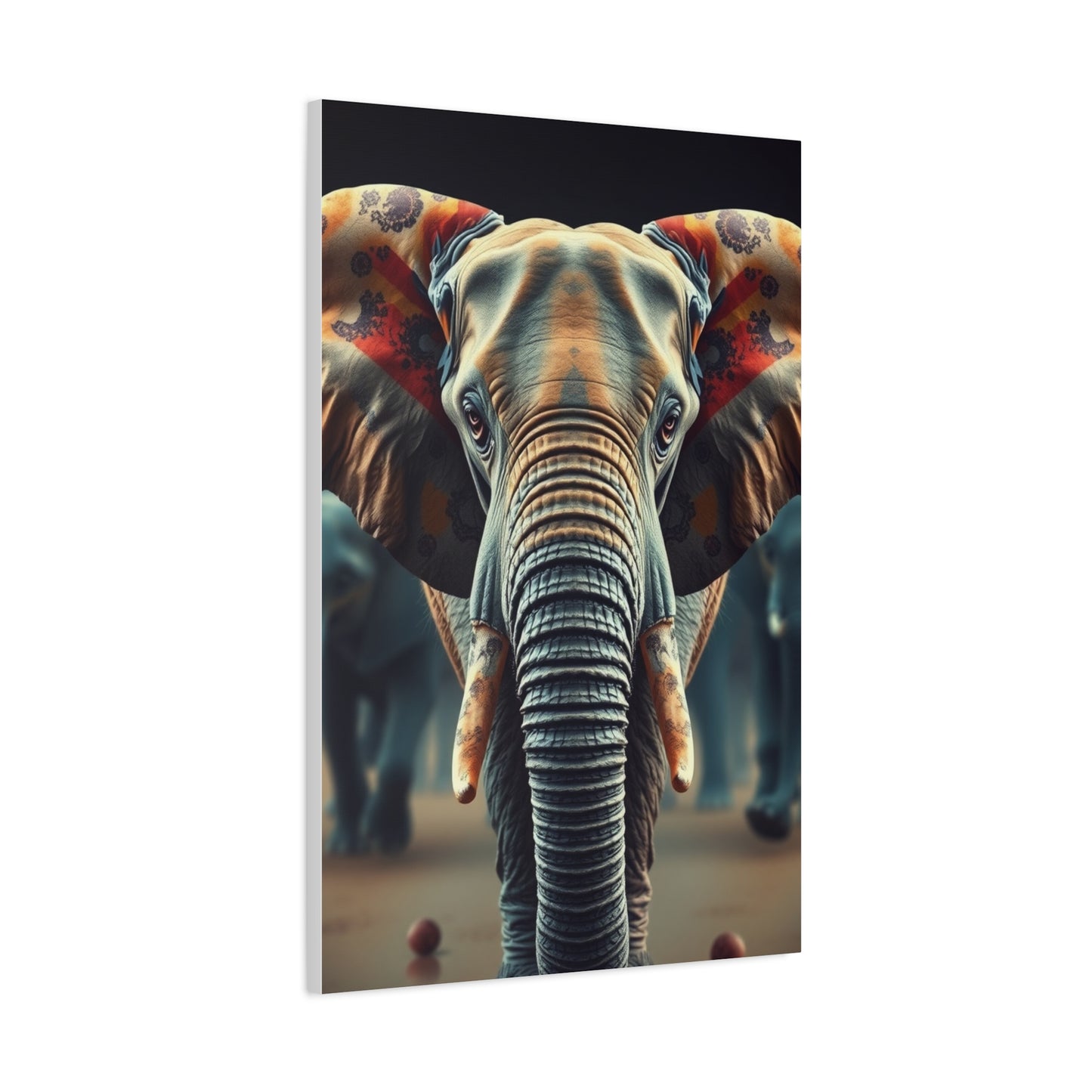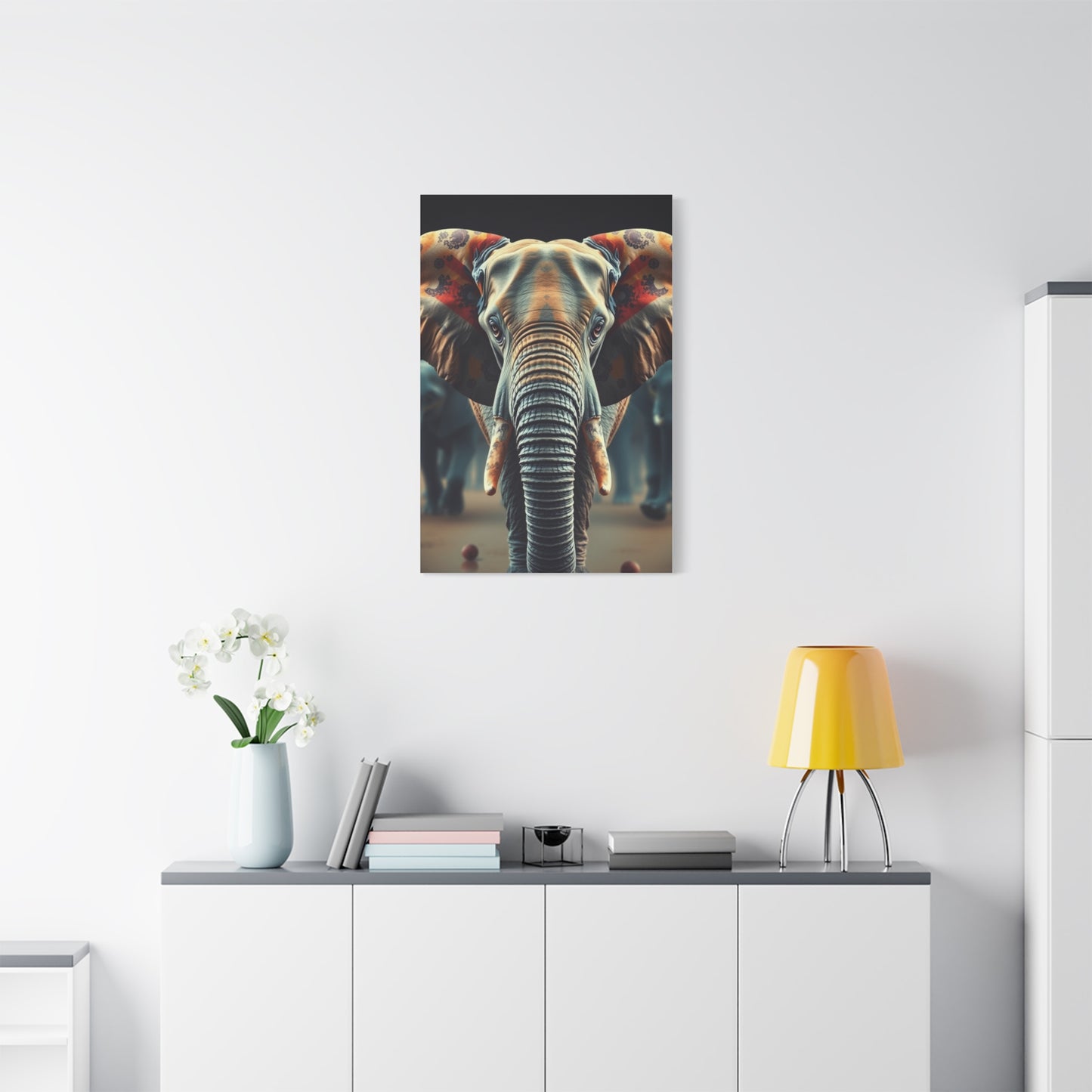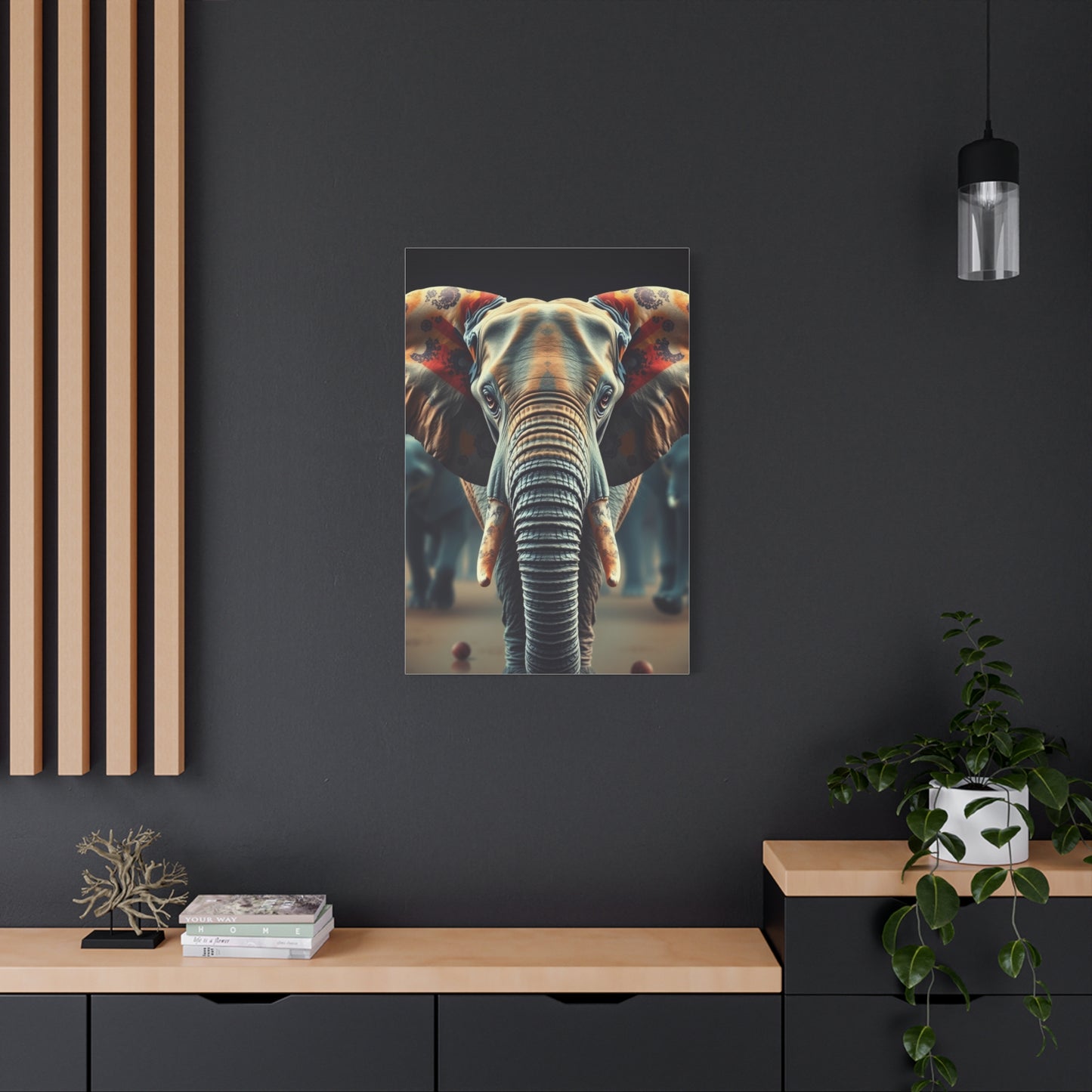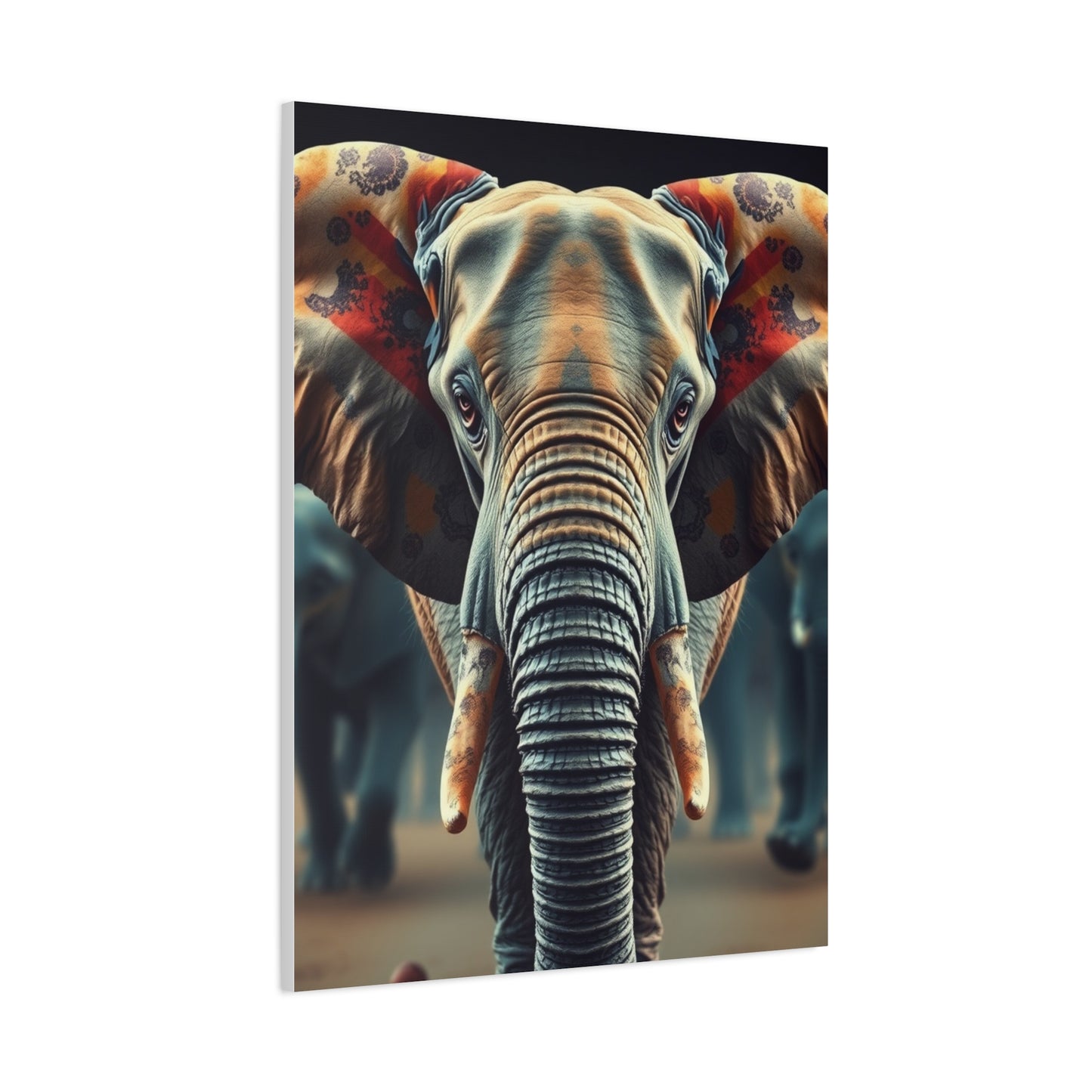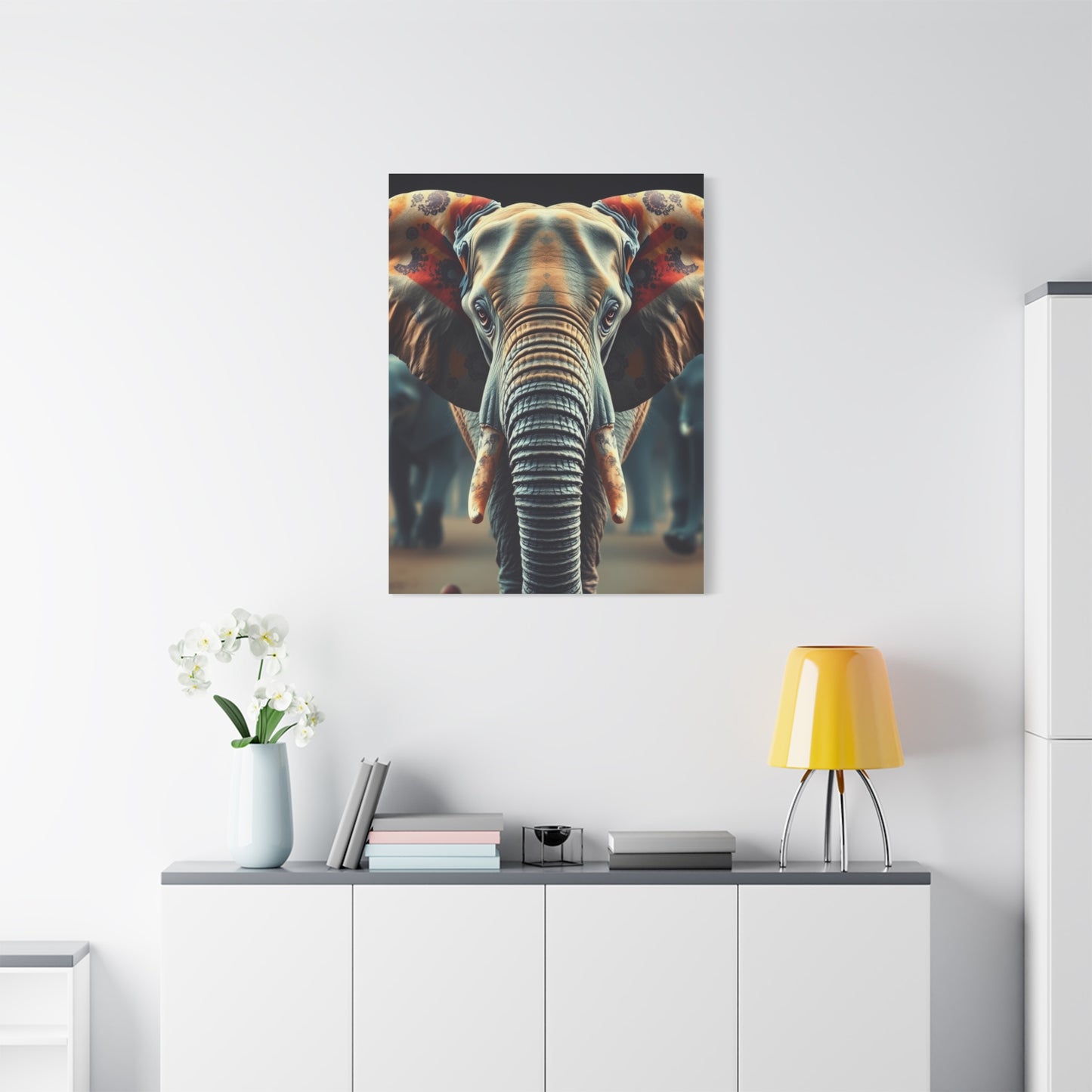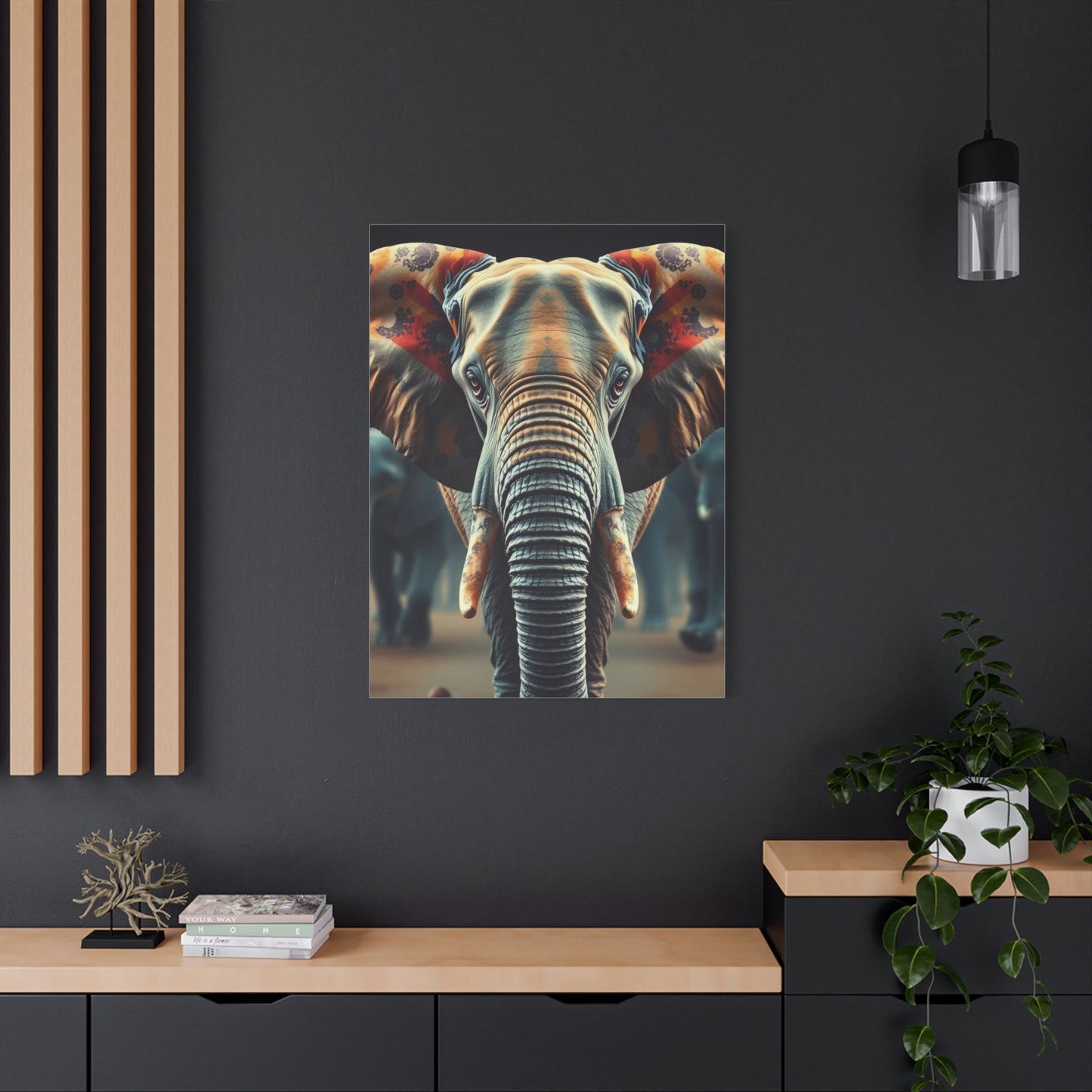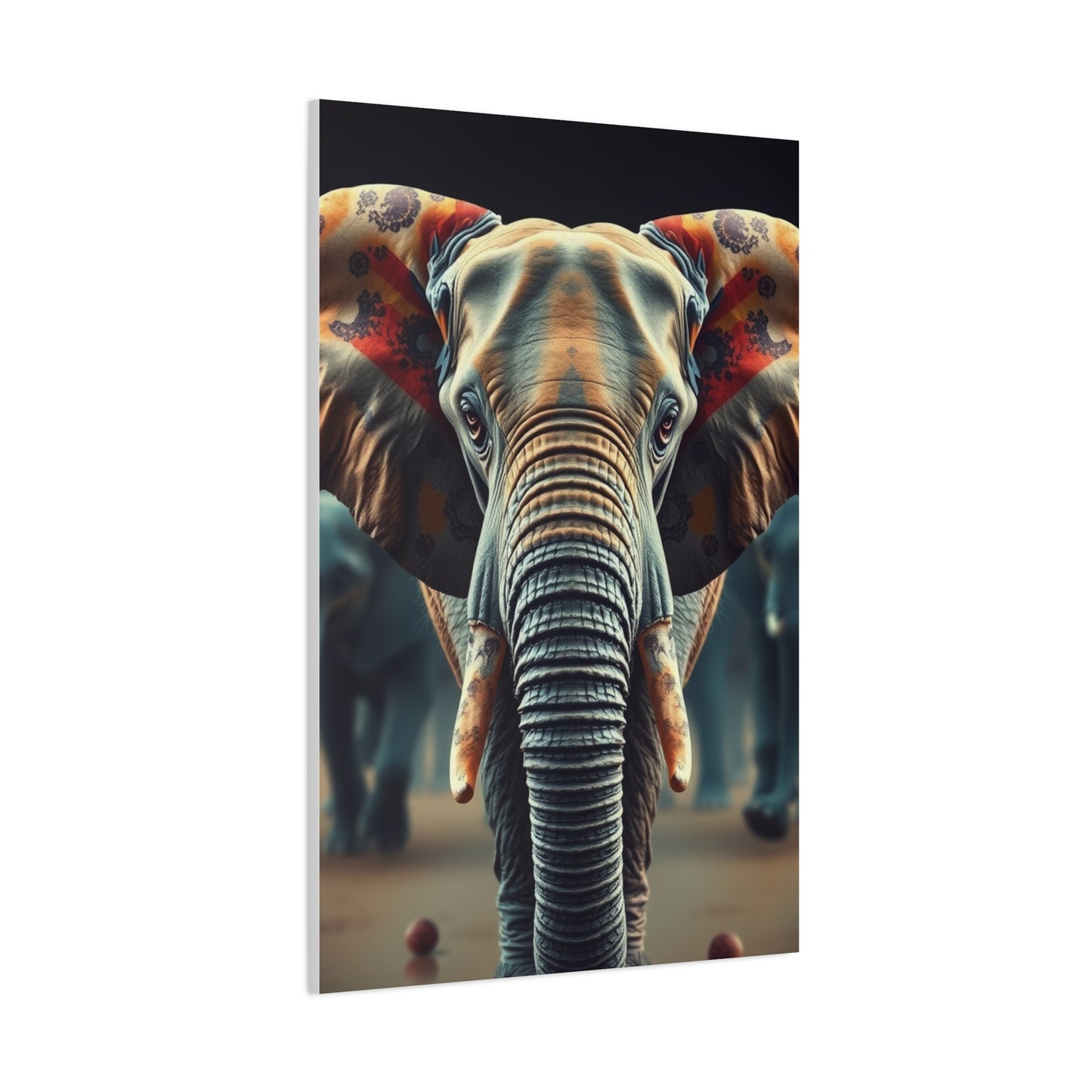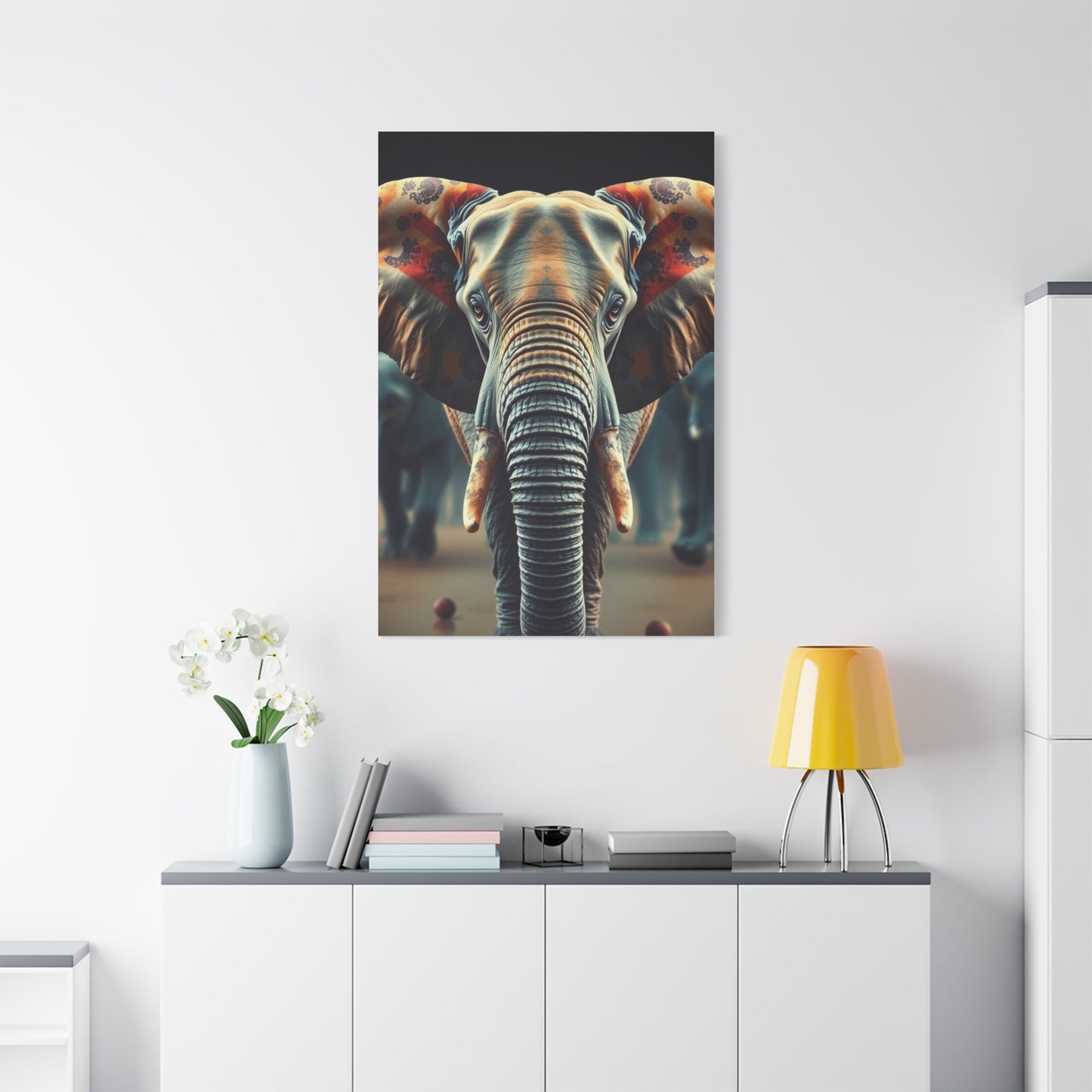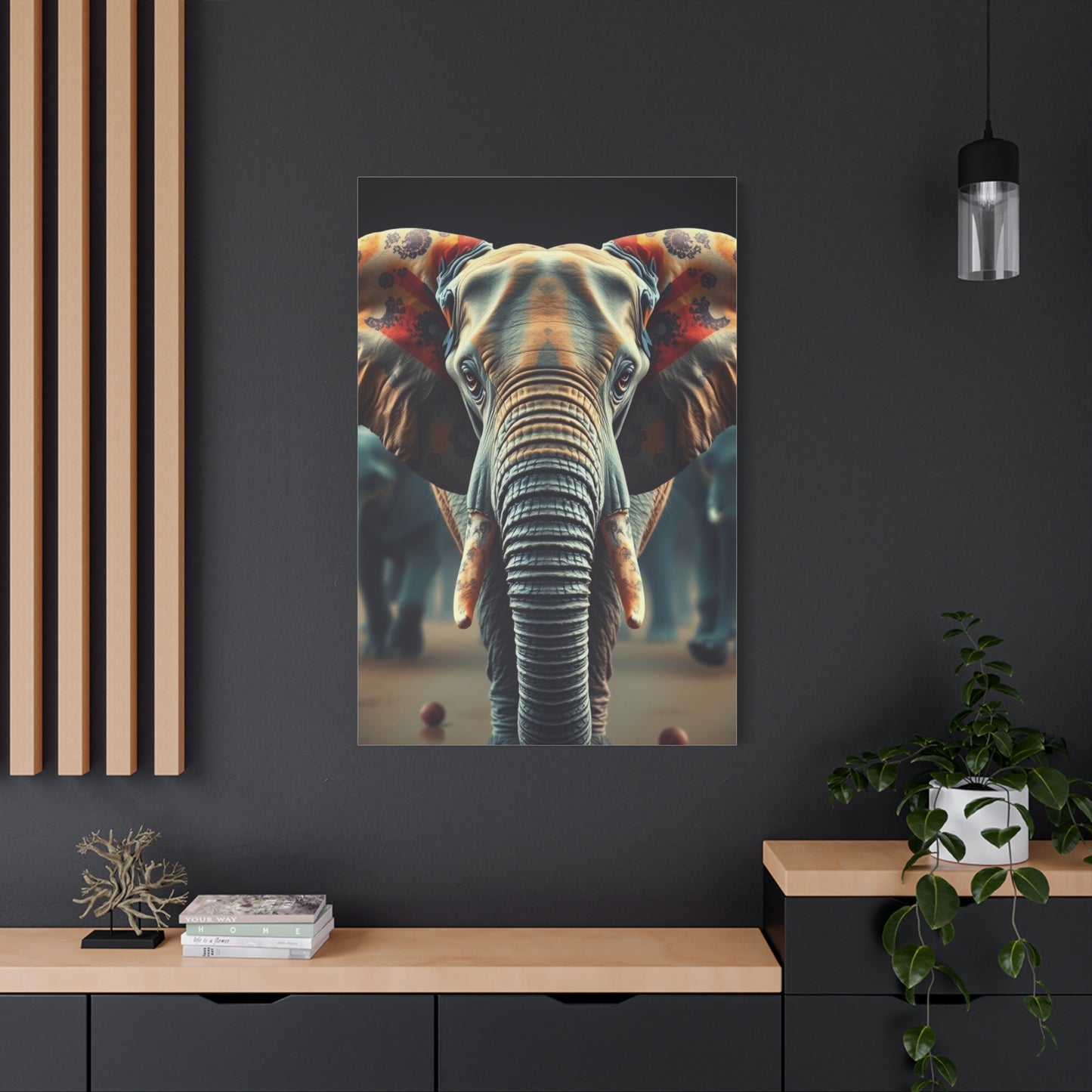The Majesty of Elephants: Exploring Regal Elephantine Reverie in Wall Art
The world of artistic expression has long celebrated the magnificence of elephants, those gentle giants that embody wisdom, strength, and grace. In contemporary home decoration, elephant-themed artwork has emerged as a sophisticated choice for those seeking to infuse their living environments with both natural beauty and cultural significance. These majestic creatures, rendered in various artistic mediums, bring an unparalleled sense of elegance and serenity to any room.
Elephant artwork transcends mere decoration, serving as a powerful symbol that connects us to the natural world while adding depth and meaning to our living environments. The appeal of elephantine imagery lies not only in the creature's impressive physical presence but also in the rich symbolism associated with these magnificent animals across different cultures worldwide.
From ancient civilizations to modern artistic movements, elephants have represented prosperity, wisdom, and good fortune. When incorporated into home décor through carefully selected artwork, these symbols can create environments that feel both luxurious and spiritually enriching. The versatility of elephant-themed art allows for seamless integration into various decorating styles, from minimalist contemporary settings to richly appointed traditional rooms.
The growing popularity of wildlife-inspired artwork reflects our increasing desire to reconnect with nature, even within our urban living environments. Elephant prints, paintings, and canvas works offer an accessible way to bring the majesty of the African savanna or Asian forests directly into our homes, creating focal points that inspire contemplation and conversation.
The Timeless Appeal of Elephantine Imagery in Modern Homes
Throughout history, elephants have captivated human imagination through their intelligence, emotional depth, and striking physical presence. These remarkable creatures possess an almost mystical quality that translates beautifully into artistic representation. The curved lines of their tusks, the textured surface of their skin, and the gentle wisdom reflected in their eyes provide artists with endless inspiration for creating compelling visual narratives.
Modern homeowners increasingly recognize the psychological benefits of incorporating nature-inspired elements into their living environments. Elephant artwork serves this purpose exceptionally well, offering viewers a sense of connection to the natural world while maintaining the sophistication required for contemporary home decoration. The presence of such artwork can transform sterile environments into warm, inviting areas that reflect personal values and aesthetic preferences.
The emotional resonance of elephant imagery extends beyond mere visual appeal. These animals are known for their strong family bonds, emotional intelligence, and remarkable memory capabilities. When we choose to display elephant artwork in our homes, we unconsciously invite these positive associations into our daily lives, creating environments that feel more harmonious and meaningful.
Contemporary artists have discovered numerous innovative approaches to depicting elephants, ranging from photorealistic representations to abstract interpretations that capture the essence of these magnificent creatures through color, form, and texture. This diversity ensures that elephant-themed artwork can complement virtually any decorating style or color scheme.
The versatility of elephantine imagery allows for creative expression across multiple artistic mediums. Whether rendered in oil paints, watercolors, digital media, or mixed materials, elephant artwork consistently delivers visual impact while maintaining broad appeal across different demographic groups and cultural backgrounds.
Exploring Different Artistic Styles in Elephant Canvas Works
The artistic interpretation of elephants offers endless possibilities for creative expression, with each style bringing unique qualities to home decoration. Realistic portrayals capture every detail of these magnificent creatures, from the intricate patterns of their skin to the intelligent gleam in their eyes. Such works often serve as stunning focal points in formal living areas or sophisticated office environments.
Abstract elephant artwork takes a different approach, using color, form, and composition to convey the essence of these creatures rather than their literal appearance. These pieces often incorporate bold colors, geometric shapes, or flowing lines that suggest movement and energy. Abstract elephant art works particularly well in contemporary settings where clean lines and modern aesthetics predominate.
Impressionistic elephant paintings offer yet another artistic avenue, combining realistic elements with loose brushwork and atmospheric effects. These pieces often evoke emotional responses through their dreamy, romantic qualities, making them ideal for bedrooms, reading nooks, or other personal retreat areas within the home.
Minimalist elephant artwork appeals to those who prefer understated elegance. These pieces typically feature simple line drawings, monochromatic color schemes, or clean geometric interpretations of elephant forms. Such artwork complements modern architectural elements while avoiding visual clutter that might overwhelm smaller rooms or spaces with existing decorative elements.
Mixed media elephant art combines various materials and techniques to create textured, multi-dimensional pieces that command attention. These works might incorporate elements like metal accents, fabric components, or three-dimensional elements that add depth and tactile interest to wall displays.
Vintage-inspired elephant artwork draws from historical artistic traditions, often incorporating aged color palettes, antique-style frames, or classical composition techniques. These pieces work beautifully in traditional homes or spaces that blend old and new decorative elements.
Color Psychology and Elephant Art Selection for Different Rooms
The selection of appropriate colors in elephant artwork significantly influences the mood and atmosphere of different living areas. Warm earth tones like amber, ochre, and burnt sienna create inviting, comfortable environments that encourage relaxation and social interaction. These colors work particularly well in family rooms, dining areas, and other gathering places within the home.
Cool color palettes featuring blues, grays, and soft greens can create calming, serene environments ideal for bedrooms, bathrooms, or meditation areas. Elephant artwork rendered in these cooler tones often evokes the peaceful quality of early morning light or misty forest environments.
Bold, vibrant colors in elephant artwork can energize and inspire, making them excellent choices for creative workrooms, children's areas, or exercise rooms. Bright oranges, vivid purples, and electric blues can transform ordinary rooms into dynamic, stimulating environments that encourage activity and creativity.
Monochromatic elephant artwork offers sophisticated elegance that complements virtually any existing color scheme. Black and white pieces provide timeless appeal that won't clash with changing decorative trends, while sepia-toned works add warmth without overwhelming existing color palettes.
Metallic accents in elephant artwork can add luxury and glamour to formal areas. Gold, silver, and copper tones create sophisticated focal points that catch and reflect light, adding visual interest and perceived value to room designs.
The psychological impact of color in elephant artwork extends beyond mere aesthetic considerations. Warm colors tend to make rooms feel more intimate and cozy, while cool colors can make small areas feel larger and more open. Understanding these principles helps homeowners select artwork that not only looks beautiful but also creates the desired emotional atmosphere.
Size and Scale Considerations for Elephant Wall Displays
Proper sizing of elephant artwork requires careful consideration of room dimensions, ceiling heights, and existing furniture arrangements. Large-scale elephant pieces can serve as dramatic focal points in spacious rooms, creating commanding presences that anchor entire decorating schemes. These substantial works often work best above sofas, mantlepieces, or dining room sideboards where they can be properly appreciated without overwhelming surrounding elements.
Medium-sized elephant artwork offers greater flexibility in placement options while still providing significant visual impact. These pieces work well in hallways, bedrooms, or smaller living areas where wall coverage is desired without dominating the entire room. Medium-scale pieces also allow for creative grouping arrangements that can be adjusted as decorating needs change.
Small elephant prints and paintings excel in creating intimate displays that add personality without demanding attention. These works are perfect for powder rooms, reading nooks, or as part of larger gallery wall arrangements that combine multiple pieces of varying sizes and subjects.
The concept of visual weight plays a crucial role in successful elephant artwork placement. Dark, highly detailed pieces appear heavier than light, minimalist works, requiring different positioning strategies to achieve balanced room compositions. Understanding visual weight helps create harmonious arrangements that feel natural and unforced.
Ceiling height significantly influences optimal artwork sizing. Rooms with standard eight-foot ceilings require different proportional considerations than those with soaring cathedral ceilings or intimate low-ceiling cottage environments. Proper scaling ensures that elephant artwork enhances rather than fights architectural features.
Multiple piece arrangements allow for creative storytelling through elephant artwork. Series of related pieces can chronicle elephant family relationships, seasonal changes, or different moods and activities. These arrangements provide opportunities for visual narrative while allowing individual pieces to complement rather than compete with each other.
Creating Focal Points with Statement Elephant Pieces
Strategic placement of elephant artwork can dramatically alter room dynamics by establishing clear focal points that guide visual attention. Large, striking elephant pieces naturally draw the eye and can effectively redirect focus away from architectural flaws or less desirable room features. This principle makes statement elephant art particularly valuable in rental properties or homes with challenging layouts.
The creation of successful focal points requires understanding sight lines and traffic patterns within rooms. Elephant artwork positioned directly opposite main entrances creates immediate visual impact for guests and family members. Similarly, pieces placed at the end of long hallways or above prominent furniture arrangements naturally command attention while providing visual anchors for room compositions.
Lighting plays a crucial role in maximizing the impact of statement elephant pieces. Proper illumination enhances colors, textures, and details while creating dramatic shadows that add depth and dimension. Track lighting, picture lights, or strategically placed table lamps can transform ordinary elephant artwork into commanding presence pieces that elevate entire room designs.
The relationship between statement elephant art and surrounding decorative elements requires careful balance. Supporting accessories should complement rather than compete with featured artwork, allowing the elephant piece to maintain its prominence while feeling integrated into the overall design scheme. This might involve selecting throw pillows, rugs, or other accessories that echo colors or themes from the artwork without duplicating them.
Seasonal rotation of statement elephant pieces offers opportunities to refresh room appearances without major decorating investments. Different elephant artworks can reflect changing seasons, holidays, or personal moods while maintaining consistent decorating themes throughout the year.
The psychological impact of focal point elephant art extends beyond mere visual appeal. Well-chosen statement pieces can influence how people feel and behave within rooms, encouraging relaxation, conversation, or contemplation depending on the specific imagery and placement strategies employed.
Incorporating Cultural Significance in Elephant Art Selection
Elephant symbolism carries deep cultural meanings across various world traditions, offering opportunities to incorporate personal values and beliefs into home decorating choices. In many Asian cultures, elephants represent prosperity, wisdom, and protection, making elephant artwork particularly meaningful for those seeking to attract positive energy into their living environments.
African cultural traditions often associate elephants with strength, memory, and family bonds, themes that resonate strongly in family-oriented home environments. Artwork that captures these cultural associations can create meaningful connections between personal values and decorative choices, resulting in more satisfying and personally relevant living environments.
Hindu traditions regard elephants as sacred animals associated with the remover of obstacles and the patron of arts and sciences. Elephant artwork that reflects these spiritual dimensions can add layers of meaning to home decorating while serving practical aesthetic purposes.
Contemporary interpretations of cultural elephant symbolism allow for modern expressions of traditional meanings. Artists today create works that honor cultural significance while appealing to contemporary aesthetic sensibilities, resulting in pieces that feel both meaningful and stylistically current.
The globalization of decorating styles has made elephant artwork with cultural significance accessible to people from all backgrounds who appreciate the rich symbolism these magnificent creatures represent. This cross-cultural appeal makes elephant art particularly valuable for creating welcoming environments that celebrate diversity and global awareness.
Understanding the cultural context of elephant artwork enhances appreciation and selection processes. Knowledge of traditional meanings can guide choices toward pieces that align with personal values and desired room atmospheres, creating more intentional and satisfying decorating outcomes.
Framing and Presentation Options for Elephant Artwork
The selection of appropriate framing significantly influences how elephant artwork is perceived and integrated into room designs. Traditional wooden frames in rich finishes like mahogany, cherry, or walnut complement classical elephant artwork while adding warmth and sophistication to formal room settings. These frames work particularly well with realistic or traditional artistic styles.
Modern metal frames offer clean, contemporary presentations that suit abstract or minimalist elephant artwork. Sleek silver, brushed gold, or matte black frames provide sophisticated borders that don't compete with artwork content while adding subtle luxury touches to modern room designs.
Floating frames create the illusion that artwork hovers slightly away from wall surfaces, adding dimensional interest and contemporary flair. This presentation style works exceptionally well with canvas elephant paintings, creating gallery-quality displays that elevate perceived artwork value.
Matting choices significantly influence how elephant artwork relates to surrounding room elements. Wide, neutral mats create breathing room around pieces while allowing flexibility in color coordination with changing decorative schemes. Colored mats can either complement or contrast with artwork colors, depending on desired visual effects.
Custom framing allows for personalized presentations that perfectly match specific elephant artwork and room requirements. Professional framers can suggest combinations of frames, mats, and glazing options that optimize artwork preservation while achieving desired aesthetic results.
Gallery-style hanging systems offer flexibility for rotating elephant artwork displays without wall damage. These systems use picture rails or track mounting that allow easy rearrangement of pieces as decorating needs change or art collections grow.
Lighting Techniques to Enhance Elephant Wall Art
Proper illumination transforms elephant artwork from simple wall decorations into compelling visual experiences that engage viewers and enhance room atmospheres. Natural lighting provides the most accurate color rendition and creates dynamic displays that change throughout the day as sun angles shift and weather conditions vary.
Artificial lighting options offer greater control over how elephant artwork appears and can be adjusted to complement different activities or moods. Track lighting systems provide focused illumination that can highlight specific pieces while avoiding glare or unwanted shadows. These systems work particularly well for larger elephant artwork that requires even light distribution.
Picture lights mounted directly on frames create intimate, gallery-quality illumination that adds elegance and importance to elephant artwork displays. LED picture lights offer energy efficiency and minimal heat production while providing consistent, high-quality light that won't fade artwork colors over time.
Accent lighting using strategically placed table lamps, floor lamps, or wall sconces can create layered illumination schemes that enhance elephant artwork while providing general room lighting. This approach works well in living areas where artwork viewing combines with other activities like reading or conversation.
Color temperature considerations affect how elephant artwork colors appear under different lighting conditions. Warm light enhances earth tones and creates cozy atmospheres, while cooler light brings out blues and greens while creating more energetic environments. Understanding these effects helps optimize lighting choices for specific elephant artwork and room functions.
Dimming controls allow adjustment of lighting levels to match different times of day, activities, or desired moods. Variable lighting can transform elephant artwork presentations from dramatic evening displays to subtle daytime accents, maximizing versatility and visual interest.
Mixing and Matching Elephant Art with Other Wildlife Themes
Combining elephant artwork with other wildlife-themed pieces creates cohesive decorating schemes that celebrate the natural world while providing varied visual interest. Safari-themed combinations featuring lions, zebras, or giraffes alongside elephant pieces can transform rooms into African-inspired retreats that feel adventurous and exotic.
Asian wildlife themes combining elephants with tigers, pandas, or exotic birds create sophisticated environments that reflect appreciation for Eastern cultures and philosophies. These combinations work particularly well in meditation rooms, studies, or other contemplative areas within homes.
Mixed wildlife galleries featuring various animal subjects including elephants can create engaging displays that appeal to nature lovers while providing conversation starters for guests. The key to successful mixed displays lies in maintaining consistent artistic styles, color palettes, or framing approaches that unify diverse subjects.
Botanical elements combined with elephant artwork create rich, layered displays that celebrate complete natural ecosystems. Plant-themed prints, paintings, or photographs can provide context for elephant pieces while adding color and texture variety to wall displays.
Landscape artwork featuring elephant habitats provides environmental context that enhances appreciation for these magnificent creatures while creating immersive room experiences. Savanna scenes, forest landscapes, or waterhole settings can transport viewers to elephant native environments.
The balance between elephant artwork and other wildlife themes requires careful attention to visual weight, color distribution, and subject prominence. Successful combinations allow each element to contribute to overall room atmospheres while maintaining individual identity and appeal.
Seasonal Rotation Strategies for Elephant Wall Displays
Rotating elephant artwork seasonally offers opportunities to refresh room appearances while maintaining consistent thematic approaches to home decoration. Summer displays might feature elephant artwork with bright, energetic colors or water-related scenes that evoke cooling thoughts during hot weather periods.
Fall rotations can incorporate elephant pieces with warm earth tones, golden lighting effects, or harvest-themed backgrounds that complement seasonal decorating elements like autumn leaves, pumpkins, or harvest displays. These combinations create cohesive seasonal atmospheres that feel intentional and well-planned.
Winter elephant artwork selections might emphasize cozy, intimate pieces that create warm feelings during cold months. Artwork featuring elephant families, protective themes, or warm color palettes can counterbalance harsh winter weather while maintaining visual interest throughout dormant seasons.
Spring rotations offer opportunities to display elephant artwork with fresh, renewal-themed imagery that celebrates new growth and energy. Pieces featuring young elephants, verdant landscapes, or bright, optimistic colors can enhance the natural sense of renewal that spring seasons bring.
Storage considerations for rotated elephant artwork require climate-controlled environments that protect pieces from temperature fluctuations, humidity changes, and physical damage. Proper storage extends artwork life while maintaining quality for future displays.
Documentation of rotation schedules and placement locations helps maintain organized approaches to seasonal displays while ensuring that all elephant artwork receives appropriate display time and appreciation throughout the year.
Budget-Friendly Options for Elephant Art Collections
Building impressive elephant artwork collections doesn't require substantial financial investments when approached strategically. Print reproductions of famous elephant paintings or photographs offer affordable ways to enjoy high-quality imagery while developing personal collections over time. Many online retailers and local print shops can produce museum-quality reproductions at fraction of original artwork costs.
Digital downloads of elephant artwork provide immediate access to vast selections of imagery that can be printed at home or local copy centers. This approach offers maximum flexibility in sizing, framing, and presentation while maintaining very low per-piece costs for expanding collections.
Emerging artist works often provide exceptional value while offering unique pieces that won't be widely duplicated in other homes. Local art fairs, online marketplaces, and student exhibitions frequently feature talented artists creating beautiful elephant artwork at accessible price points.
DIY framing projects can significantly reduce display costs while allowing complete customization of presentation styles. Basic framing materials and tools enable creative homeowners to achieve professional-looking results while building practical skills for future projects.
Thrift stores, estate sales, and consignment shops occasionally offer elephant artwork at substantial discounts from retail prices. Patient shoppers willing to search regularly can discover exceptional pieces that would be prohibitively expensive when purchased new.
Group purchasing or art share arrangements with friends or family members can make higher-end elephant pieces more accessible through shared ownership or rotation agreements. These collaborative approaches can provide access to museum-quality works that individual budgets might not accommodate.
Maintenance and Preservation of Elephant Canvas Art
Proper care extends the life and beauty of elephant artwork while protecting investment values over time. Regular dusting using soft, dry brushes or microfiber cloths prevents accumulation of particles that can dull colors or create permanent staining. Gentle cleaning motions following brush stroke directions help maintain surface integrity.
Environmental controls significantly impact artwork longevity and appearance. Stable temperature and humidity levels prevent expansion and contraction that can crack paint or damage canvas materials. Avoiding placement near heating vents, fireplaces, or windows with direct sunlight helps maintain stable conditions.
UV protection through specialized glazing or window treatments prevents fading and color deterioration that can permanently damage elephant artwork. Museum-quality UV filtering glass or acrylic glazing provides maximum protection while maintaining visual clarity and color accuracy.
Professional cleaning services can address serious soiling or damage that exceeds homeowner capabilities. Art conservators possess specialized knowledge and materials required for safely restoring elephant artwork while preserving original artistic intent and value.
Insurance documentation and appraisals protect financial investments in valuable elephant artwork while providing peace of mind against loss or damage. Professional appraisals establish current market values for insurance purposes while creating records of artwork condition and provenance.
Proper handling techniques during cleaning, moving, or storage prevent accidental damage that can be costly to repair. Learning correct lifting, carrying, and hanging procedures helps preserve elephant artwork while ensuring personal safety during maintenance activities.
Custom Commissioning of Elephant Artwork
Commissioning custom elephant artwork allows for personalized pieces that perfectly match specific decorating needs, personal preferences, and available room dimensions. Working directly with artists provides opportunities to influence composition, color choices, and artistic styles while creating unique pieces that won't be duplicated elsewhere.
The commissioning process typically begins with discussions of desired outcomes, artistic styles, and budget parameters. Clear communication about expectations, timelines, and deliverables helps ensure successful collaborations that satisfy both artists and homeowners while avoiding misunderstandings.
Reference materials including photographs, color samples, and room measurements help artists understand project requirements and create appropriate designs. Providing detailed information about intended placement locations, lighting conditions, and surrounding decorative elements enables artists to optimize designs for specific environments.
Multiple revision stages allow refinement of designs before final execution begins. Most commissioned artwork projects include opportunities to review preliminary sketches, make adjustments, and approve final concepts before artists invest significant time in completion.
Payment structures for commissioned elephant artwork typically involve deposits upon agreement, progress payments during execution, and final payments upon satisfactory completion. Understanding these arrangements helps budget appropriately while providing security for both parties.
Documentation of commission agreements protects both artists and homeowners while establishing clear expectations for deliverables, timelines, and quality standards. Written contracts prevent disputes while providing frameworks for successful creative collaborations.
Digital vs. Traditional Elephant Art Mediums
Digital elephant artwork offers unprecedented flexibility in customization, reproduction, and distribution while maintaining high quality and resolution. Digital artists can easily adjust colors, compositions, and sizes to match specific requirements while providing immediate delivery through electronic transmission.
Traditional mediums like oil paints, watercolors, and pastels provide tactile qualities and authentic artistic character that many collectors prefer. These works often feature subtle texture variations, brush strokes, and color nuances that create unique viewing experiences impossible to replicate digitally.
Hybrid approaches combining digital design with traditional printing or painting techniques offer advantages of both mediums while creating unique artistic expressions. Many contemporary artists use digital tools for initial designs before executing final works using traditional materials and techniques.
Cost considerations often favor digital elephant artwork for budget-conscious collectors, while traditional pieces typically command higher prices due to time investments and material costs. Understanding these differences helps guide selection decisions based on available resources and collection goals.
Longevity comparisons between digital and traditional elephant artwork depend on specific materials, production methods, and display conditions. High-quality digital prints on archival materials can last decades with proper care, while traditional works may require more extensive conservation efforts.
Authenticity questions arise more frequently with digital elephant artwork due to ease of reproduction and distribution. Traditional pieces offer clearer provenance and uniqueness that appeals to serious collectors while digital works provide accessibility for broader audiences.
Gallery Wall Creation with Elephant Art Collections
Gallery walls featuring multiple elephant artwork pieces create dramatic visual impacts while showcasing personal collections and artistic preferences. Successful gallery arrangements require careful planning of spacing, sizing, and thematic relationships between individual pieces while maintaining overall visual harmony.
Planning gallery layouts begins with paper templates or digital mockups that allow experimentation with arrangements before committing to wall mounting. These preliminary exercises help identify optimal spacing, alignment, and compositional balance while avoiding costly mistakes or wall damage.
Thematic approaches to elephant gallery walls can focus on artistic styles, color palettes, or subject variations while maintaining cohesive appearances. Collections might feature elephant families, different artistic interpretations of single subjects, or chronological progressions showing artistic development over time.
Mixed media gallery walls combine elephant artwork in various formats including paintings, prints, photographs, and three-dimensional pieces. These diverse approaches create textural interest and visual depth while accommodating different artistic expressions and price points.
Lighting considerations for gallery walls require even illumination across multiple pieces while avoiding shadows or glare that might detract from individual works. Track lighting systems or multiple picture lights can provide appropriate illumination for complex arrangements.
Growth planning allows gallery walls to evolve as collections expand or personal preferences change. Flexible hanging systems and modular approaches enable easy rearrangement or addition of new elephant pieces without major wall modifications or extensive rehanging efforts.
The Psychology of Elephant Imagery in Home Environments
The presence of elephant artwork in home environments can significantly influence mood, behavior, and psychological well-being through the symbolic associations these magnificent creatures carry. Research in environmental psychology suggests that nature-inspired imagery, including elephant art, can reduce stress levels while promoting feelings of calm and connection to the natural world.
Elephant imagery often evokes feelings of stability, wisdom, and protection due to cultural associations and the animals' observed behaviors in natural settings. These positive associations can create psychological anchors within homes that provide comfort and security, particularly valuable in today's fast-paced, technology-dominated lifestyle environments.
The scale and presence of elephant artwork can influence perceptions of room size and importance while creating focal points that encourage contemplation and mindfulness. Large elephant pieces often inspire feelings of awe and respect that can transform ordinary rooms into special, meaningful environments.
Color psychology interacts with elephant imagery to create complex emotional responses that vary based on artistic treatment and personal associations. Warm-toned elephant artwork might evoke comfort and security, while cooler palettes could inspire calm reflection or spiritual contemplation.
Family-oriented elephant imagery featuring protective relationships and generational bonds can reinforce positive family values while creating environments that celebrate relationships and togetherness. These symbolic connections can strengthen household dynamics and shared family identity.
The therapeutic potential of elephant artwork lies in its ability to provide positive visual anchors during stressful periods while maintaining consistent symbolic meaning that transcends daily challenges. This stability can be particularly valuable in bedrooms, meditation areas, or other personal retreat locations within homes.
Elephant Art in Different Architectural Styles
Contemporary architectural styles with clean lines and minimal ornamentation provide ideal backdrops for bold, statement elephant artwork that can serve as primary decorative elements. Modern homes often benefit from large-scale elephant pieces that complement geometric architectural features while adding organic warmth to potentially sterile environments.
Traditional architectural styles featuring rich woodwork, elaborate moldings, and formal proportions often accommodate classical elephant artwork with realistic rendering and traditional framing approaches. These combinations create harmonious relationships between artistic and architectural elements while maintaining period-appropriate aesthetic consistency.
Rustic or farmhouse architectural styles pair beautifully with elephant artwork featuring earth tones, natural materials, or folk art approaches. These combinations enhance the connection to nature that rustic styles celebrate while adding sophistication and global awareness to country-inspired environments.
Industrial architectural elements like exposed brick, steel beams, and concrete surfaces create striking contrasts with elegant elephant artwork, resulting in dynamic visual tension that energizes room environments. These unexpected combinations can transform stark industrial elements into sophisticated design features.
Mediterranean or Spanish-influenced architectural styles with warm colors, textured walls, and arched openings complement elephant artwork featuring similar warm palettes and exotic themes. These combinations enhance the global, well-traveled feeling that Mediterranean styles often seek to achieve.
Colonial architectural styles with formal symmetry and historical references can accommodate elephant artwork that reflects traditional artistic approaches or cultural themes from colonial periods. These combinations create sophisticated, worldly environments that celebrate cultural exchange and historical awareness.
Feng Shui Applications of Elephant Wall Art
Feng shui principles offer specific guidance for incorporating elephant artwork into home environments to optimize energy flow and promote positive life outcomes. According to traditional feng shui teachings, elephants represent strength, wisdom, and good fortune, making them powerful symbols for enhancing various life areas through strategic placement.
The entrance area of homes benefits significantly from elephant artwork placement, as these images can attract positive energy while providing protection against negative influences. Feng shui practitioners often recommend positioning elephant imagery near front doors or in foyer areas where they can welcome beneficial energy into living environments.
Wealth and prosperity areas of homes, typically located in southeast corners according to feng shui mapping, can be enhanced through carefully selected elephant artwork. Images featuring elephants with raised trunks are particularly favored for attracting financial abundance and career success.
Career and reputation areas benefit from elephant artwork that emphasizes wisdom, leadership, and strength characteristics. These pieces can support professional development goals while creating environments that inspire confidence and decision-making capabilities.
Family and relationship areas of homes can be strengthened through elephant artwork depicting family groups, protective relationships, or nurturing behaviors. These images reinforce positive family dynamics while attracting harmonious relationships and emotional stability.
Color selection in feng shui elephant artwork should complement the specific area's elemental associations while supporting desired outcomes. Earth-toned elephants enhance stability and grounding, while metallic accents can support wealth and abundance goals.
Care Instructions for Different Elephant Art Materials
Canvas elephant artwork requires specific care approaches that protect fabric surfaces while maintaining color integrity and structural stability. Regular dusting with soft brushes prevents particle accumulation while gentle cleaning with slightly damp cloths can address minor soiling without damaging paint layers or canvas fibers.
Paper-based elephant prints and drawings need protection from humidity, direct sunlight, and handling damage that can cause permanent deterioration. Proper framing with UV-filtering glazing provides essential protection while maintaining visual access to artwork details and colors.
Metal elephant artwork, whether featuring painted surfaces or natural finishes, requires protection from moisture and oxidation that can cause permanent damage. Regular dusting and occasional application of appropriate protective coatings helps maintain appearance while preventing corrosion or surface degradation.
Fabric elephant tapestries or textile artwork need protection from moths, fading, and mechanical damage through proper storage and display techniques. Rotation between display and storage helps prevent excessive light exposure while allowing enjoyment of these delicate pieces.
Mixed media elephant artwork combining various materials requires understanding of each component's care requirements to prevent damage to any single element. Professional conservation advice may be necessary for valuable pieces or those showing signs of deterioration.
Photographic elephant artwork on various substrates requires protection from environmental factors while maintaining image clarity and color accuracy. Proper framing, controlled lighting, and stable environmental conditions help preserve these images for long-term enjoyment.
Trending Styles in Contemporary Elephant Art
Minimalist elephant artwork featuring clean lines, limited color palettes, and geometric interpretations reflects current design trends favoring simplicity and sophistication. These pieces work exceptionally well in modern homes where visual clarity and uncluttered aesthetics are priorities.
Abstract expressionist elephant artwork explores emotional and spiritual dimensions of these magnificent creatures through bold colors, dynamic brushwork, and non-representational approaches. These pieces appeal to collectors seeking artwork that provokes thought and emotional response rather than literal representation.
Photorealistic elephant artwork showcases technical mastery while providing intimate connections to these magnificent creatures. High-definition printing technology and advanced painting techniques enable artists to create works that capture every detail of elephant anatomy and expression.
Mixed media elephant artwork combining traditional painting with digital elements, collage materials, or three-dimensional components creates textured, multi-layered pieces that command attention. These approaches appeal to contemporary collectors seeking unique, conversation-starting artwork.
Cultural fusion elephant artwork blends traditional cultural symbols and techniques with contemporary artistic expressions, creating pieces that honor heritage while appealing to modern aesthetic sensibilities. These works often feature traditional patterns, cultural colors, or symbolic elements alongside contemporary composition approaches.
Sustainable elephant artwork created using environmentally responsible materials and processes appeals to environmentally conscious collectors while supporting conservation efforts. These pieces often incorporate recycled materials, non-toxic media, or support elephant conservation organizations through sales proceeds.
Regional and Cultural Variations in Elephant Artwork
African elephant artwork often emphasizes the raw power and natural beauty of these magnificent creatures in their native savanna environments. Artists from African traditions frequently incorporate earth tones, traditional patterns, and cultural symbols that reflect deep connections between human communities and elephant populations.
Asian elephant artwork typically features more decorative approaches that reflect the cultural significance of elephants in Hindu, Buddhist, and other Eastern religious traditions. These pieces often include elaborate ornamentation, religious symbolism, and ceremonial elements that celebrate elephants' sacred status in many Asian cultures.
Western interpretations of elephant artwork tend to focus on conservation themes, emotional connections, or artistic exploration of form and color. Contemporary Western artists often approach elephant subjects through personal artistic vision rather than traditional cultural frameworks.
Indigenous artistic traditions from various regions offer unique perspectives on elephant imagery that reflect specific cultural relationships with these animals. These works often incorporate traditional materials, techniques, and symbolic systems that provide authentic cultural expressions.
Modern global fusion approaches combine elements from multiple cultural traditions to create elephant artwork that celebrates international awareness and cultural exchange. These pieces often appeal to cosmopolitan collectors seeking artwork that reflects global perspectives and cultural appreciation.
Regional color preferences and artistic techniques create distinctive variations in elephant artwork that reflect local aesthetic traditions and available materials. Understanding these variations helps collectors appreciate the cultural contexts that influence artistic expression.
Investment Potential of Elephant Wall Art
Original elephant artwork by established artists can appreciate significantly in value over time, particularly pieces by artists with growing reputations or those addressing conservation themes that increase in relevance. Careful research of artist backgrounds, market trends, and collecting patterns helps identify potentially valuable acquisition opportunities.
Limited edition elephant prints and photographs often provide more accessible entry points into art investment while offering potential appreciation as edition sizes sell out. Understanding edition sizes, signing practices, and authentication procedures helps evaluate investment potential for print-based elephant artwork.
Emerging artist elephant artwork can provide exceptional investment opportunities when artists develop substantial followings or gain critical recognition. Early acquisition of works by promising artists offers potential for significant appreciation while supporting artistic development.
Market factors influencing elephant artwork values include conservation awareness, cultural trends, and general art market conditions. Understanding these broader influences helps inform collection decisions and timing for acquisitions or sales.
Provenance documentation and condition reports provide essential information for evaluating elephant artwork investment potential while protecting against fraud or misrepresentation. Professional appraisals and authentication services offer expertise for significant acquisition decisions.
Geographic market variations can create opportunities for acquiring elephant artwork in undervalued regional markets while selling in areas where demand and prices are higher. Understanding these market dynamics requires research and professional guidance for optimal results.
Conclusion
The world of elephant wall art offers an extraordinary array of possibilities for enhancing home environments with meaningful, beautiful, and culturally rich imagery. These magnificent creatures, captured through various artistic mediums and interpretations, bring more than mere decoration to our living environments. They introduce elements of wisdom, strength, protection, and natural beauty that can transform ordinary rooms into extraordinary personal sanctuaries.
Throughout this extensive exploration, we have discovered that elephant artwork transcends simple aesthetic considerations to become powerful tools for personal expression, cultural celebration, and psychological well-being. The versatility of elephantine imagery allows for seamless integration into virtually any decorating style, from ultra-modern minimalist environments to richly appointed traditional settings. This adaptability ensures that elephant art remains relevant and appealing across changing design trends and personal preferences.
The cultural significance of elephants across different world traditions adds layers of meaning that extend far beyond visual appeal. Whether drawing from African traditions that celebrate strength and community bonds, Asian cultures that revere elephants as sacred beings, or contemporary conservation movements that highlight our responsibility to protect these magnificent creatures, elephant artwork serves as a bridge between personal aesthetic choices and broader cultural values.
The practical aspects of incorporating elephant art into home environments require thoughtful consideration of factors such as sizing, placement, lighting, and care requirements. However, the investment of time and attention needed to properly display and maintain elephant artwork pays dividends in the form of rooms that feel more welcoming, meaningful, and personally expressive. The psychological benefits of living with nature-inspired imagery, particularly imagery as powerful and positive as elephant art, contribute to overall well-being and life satisfaction.
The market for elephant artwork continues to evolve, offering options for every budget level and aesthetic preference. From affordable print reproductions that provide access to museum-quality imagery to original works by established artists that represent significant investment opportunities, the elephant art market accommodates collectors at all levels. This accessibility ensures that the benefits of elephant imagery can be enjoyed regardless of financial circumstances or collecting experience.
The future of elephant wall art appears bright, with contemporary artists continuing to find new and innovative ways to interpret these magnificent creatures. Digital technologies, sustainable materials, and cross-cultural artistic collaboration are creating exciting possibilities for elephant artwork that speaks to modern concerns while honoring traditional meanings and artistic techniques.
For those considering adding elephant artwork to their homes, the key lies in selecting pieces that resonate personally while complementing existing decorative elements and lifestyle needs. Whether choosing a single statement piece that transforms an entire room or building a comprehensive collection that can be displayed and rotated over time, elephant artwork offers opportunities for creating more meaningful, beautiful, and culturally rich living environments.
The journey of incorporating elephant wall art into home decoration is ultimately a personal one, reflecting individual tastes, values, and aspirations. However, the universal appeal of these magnificent creatures, combined with their rich symbolic meanings and artistic potential, ensures that elephant artwork will continue to inspire and delight homeowners for generations to come. The investment in elephant art is truly an investment in creating homes that nurture the soul while celebrating the magnificent diversity and beauty of our natural world.

















